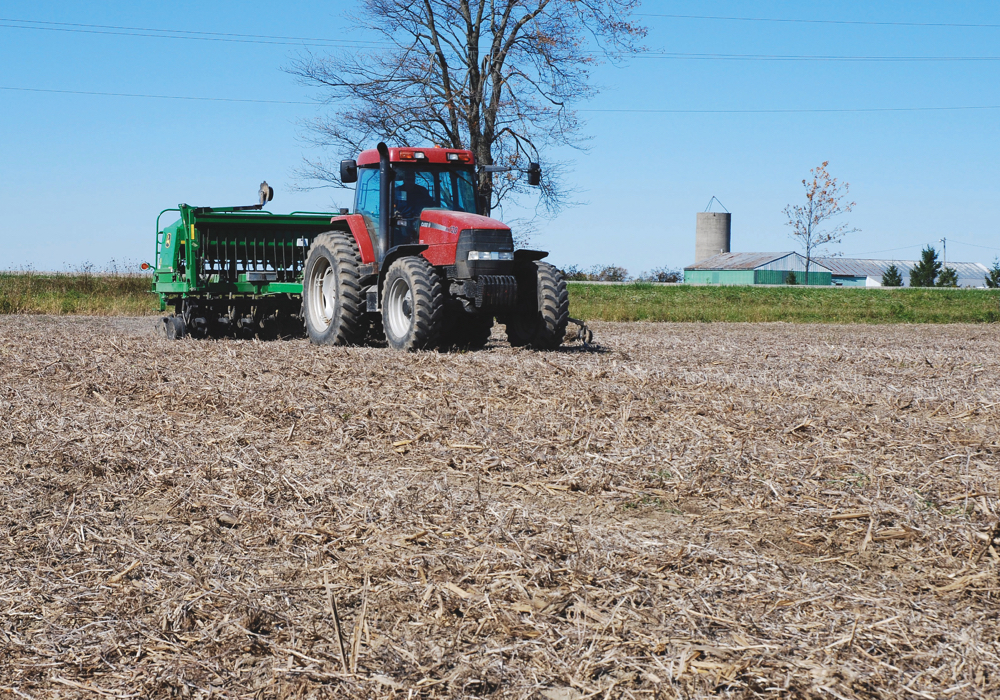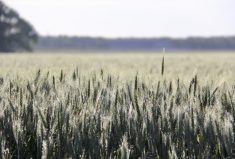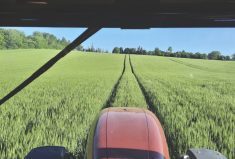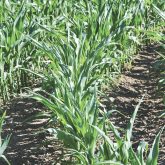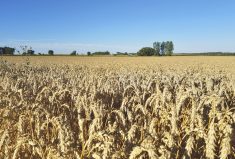Into a 2019 growing season long on frustration and short on sunlight comes an opportunity for wheat growers in Ontario: identity-preservation (IP) programs aimed at boosting production of hard red winter wheat. The initiative is meant to tackle declining supply, which, according to some in the industry, has reached levels that pose a viability concern for domestic millers.
These programs will take effect this fall as growers go to the fields to plant their winter wheat acres, with a premium for hard red winter varieties over and above the price for soft red wheat. Hard red is the class of wheat that is favoured most by bakers, particularly those trying to market products within the local food movement.
Read Also

Sensing the soil: Root cell research finds ‘stress hormone’
Research into how root cells react to soil stressors could help plants better adapt to changes in their climate.
Growers wishing to participate will have to adhere to three parameters: use of certified seed (ensuring end-users get what they need), strong quality values relative to soft red wheat, and an early booking date (to lock in the best value for the season).
Those parameters might seem onerous. Instead, though, most participants believe the program should be viewed as an opportunity to add to profit margins and to diversify crop rotations.
Parrish & Heimbecker initiated its IP program this past February as a means of generating interest among growers in advance of winter wheat planting in the fall. ADM Milling also initiated its own program, working with partners such as Sollio Agriculture, Hensall District Co-op and London Agricultural Commodities (LAC).
Andy Wilder, grain merchant with Parrish & Heimbecker, agrees that millers in Eastern Canada have been challenged by a relative shortage of hard red wheat and that the IP program will remove some of the uncertainty for producers. He emphasizes that as downstream users continue to broaden their uses of hard red wheat, the demand will also grow.

Thus far, the program is shaping up well.
“We have it linked to soft red pricing, so they have the same pricing options and it’s really just a premium to soft red,” says Wilder. “The growers like the flexibility in that they don’t have to lock in the soft red price. Instead, they know that they have a contract with us that pays them a premium over soft red.”
Wheat recovery
In the past few years, a troubling sentiment expressed among growers and retailers is that there’s no money in growing wheat, a notion that’s contrary to nearly 30 years of research into crop rotations. It’s also not evident in statistics that show Ontario growers have planted more than 900,000 acres of winter wheat in three of the past four growing seasons (2015 to 2018, with 625,000 acres harvested in 2015). Granted, there has been serious frustration with the 2019 growing season, which saw 957,000 acres of winter wheat planted (according to Statistics Canada), but which have suffered enormously from a prolonged cool, wet spring.
Wilder acknowledges wheat’s reputation and challenges of late, particularly compared to the simplicity of transgenic corn hybrids and soybean varieties. But he also points to the overlooked benefits of wheat production, including straw prices (which are expected to be high in 2019), savings from nitrogen credits (from subsequent cover crops) and soil health benefits (from more diverse rotations).
“It really depends on how you want to look at the economics and what you take into account,” Wilder says. “You can spin it any way you want.”
Long-term growth
This is a different scenario compared to 2015, when Ontario’s wheat sector attempted to re-establish a market demand for soft red winter wheat with the Mondelez Flour Mill in Toledo, Ohio. Although dubbed an IP opportunity for growers, it was driven more to entice Mondelez millers back to Ontario wheat.
It also differs from the IP soybean market, primarily because of the challenges of getting growers to shift to IP soybeans against the convenience of growing herbicide-tolerant lines. It’s a premium over the CBoT price but it’s not the domestic downstream users who are driving it, as with the IP program for hard red winter wheat. In this case, millers and other users are willing to pay extra to secure their supply.
These new IP initiatives answer the growing demand for hard red winter wheat in the face of a significant shortage in that class. And there’s little, if any, concern that growers might eventually overproduce hard red wheat in Ontario.
“You always have to be careful with things like that, but right now, it feels as though there’s room to grow it back to the levels that we’ve seen in the past,” says Rick Steinke, Canadian grain manager with ADM Milling. “If at some point, farmers continue to embrace it over a number of years, then yes, the supply might reach the point where it’s meeting demand. But we won’t know that until we get down the road and build on it.”
Steinke agrees that there’s a need for this program and notes that ADM is very supportive of growing “local wheats” in Ontario, and that the company would like to see this production increase and come back to the marketplace. To that end, ADM has started their IP venture for hard red wheat and is promoting local production and ensuring growers get the signal that there is a demand for it.
“We’re trying to provide our baking customers and the marketplace with a consistent product,” says Steinke. “We like to have enough supply for a 12-month period but what can hurt programs is if you can’t get enough volume to keep those customers going in a sustainable way, and consumers typically don’t like change in products. We’re in it for the long run and we want to see the volume grow and become more stable.”
Steinke even turns the seriousness of the situation into a positive, preferring to address it as a “serious opportunity,” as opposed to something more pressing. In the wake of trade conflicts between the U.S. and China and the export market filled by Western Canada grain production, the IP red wheat program is an opportunity for growers on a domestic level to fill a growing and stable market and earn a premium.
“Based on the economics I see, farmers can be better off growing this wheat compared to soft red winter, and there’s a serious opportunity here — and a shortfall in the market,” says Steinke. “That’s why you’re seeing this (IP program) develop. There’s room in the marketplace to make more money for your farm: it’s stable, it’s real and it’s going to be there.”
Mixed or missed messaging?
There’s also the misconception in Ontario that soft red wheat was favoured ahead of the demand for hard red wheat. But that’s not the case, says Russell McLaughlin of Sollio Agriculture in Palmerston, Ont. Miller demand for hard red has been consistent, and the decline in supply has been noticed by the millers, which is why they’ve supported a premium to acquire the tonnage earlier and ensure the volumes will be available.
“I’ve heard comments of ‘nobody wants Ontario hard red winter wheat,’ which just isn’t true,” says McLaughlin. “Based upon what the flour customers are telling us, we’re at the start of a demand change to more locally sourced hard red winter. So we believe in the future this demand will continue to grow the same way we see other locally-sourced demands evolve.”
The important thing, from McLaughlin’s perspective, is that demand for hard red milling wheat is high compared to its supply: he says it’s hard to find a stable supply of hard red wheat in Ontario today. It’s all the more reason for an IP program to help get the acres in the ground.
“We could see hard wheat disappear further from the rotation if farmers don’t see the value over soft red wheat,” says McLaughlin. “A program to ensure acres is needed to keep hard red winter wheat from shrinking.”
Setting the record straight
Rob McLaughlin keeps hearing the complaint from growers: “How do I make money with wheat?” His quick response has two parts: “Learn how to grow wheat, and how to market it.”
As sales and marketing manager with C&M Seeds in Palmerston, Ont., McLaughlin knows he may seem self-serving. Yet in the wake of growing anti-wheat sentiments, he says the record needs to be set straight.
McLaughlin understands the influences affecting planting decisions all too well. In spite of a tough 2019 growing season, wheat remains that crop that is most influenced by fall weather conditions. Added to that is the wealth of insight and opinions of those surrounding the farmer — from their agronomist to their grain buyer, from the local elevator to provincial extension personnel, as well as seed and chemical company representatives.
The demand for certified seed in an IP wheat program may create some reluctance among producers, but the reality is that such requirements will spread to other crops too, especially with today’s calls for sustainability and traceability. Millers and downstream users are trying to create assurances for customers, a trend that is bound to affect transgenic corn or soybeans.
Ultimately, keeping wheat in the rotation is better for a grower’s bottom line, but McLaughlin doesn’t stop there. He’d like to see longer rotations that include hay or even canola.
“There’s a fine line between long rotations and money in the bank,” he says. As farms become more expensive, he says, land quality is only going to grow as a financial driver.


